|
|
|
Sort Order |
|
|
|
Items / Page
|
|
|
|
|
|
|
| Srl | Item |
| 1 |
ID:
182611
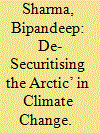

|
|
|
|
|
| Summary/Abstract |
The rapidly transforming Arctic has led to rethink the concept of security in the region. The increasing global warming and opening up of the Arctic have brought multiple geopolitical issues before the Arctic and non-Arctic states.1 In pursuit of their perceived geopolitical, geo-economics and strategic interests, a race to ‘securitise the Arctic’ has started amongst the major Arctic states. This process of securitisation appears to be dictated and driven not only by traditional military-strategic considerations but also by non-traditional security threat dilemmas related to energy, environment, sustainability, human security, connectivity, etc. As the old and the new Arctic challenges are being taken out of the realm of ‘normal politics’ and placed in the contested domain of ‘security politics’, the Asian states, that are directly or indirectly impacted by the changing Arctic realise that securitisation of the Arctic is leaving little space for addressing common issues of global concern. This study argues that all these emerging issues (otherwise perceived as ‘security threats’) in the Arctic, instead of being addressed in the securitisation framework, could and should be approached and addressed as compelling reasons for mutual cooperation and thus in need of de-securitisation.
|
|
|
|
|
|
|
|
|
|
|
|
|
|
|
|
| 2 |
ID:
182609


|
|
|
|
|
| Summary/Abstract |
The renewed and reinvigorated engagement of India with the South Asian Association for Regional Cooperation (SAARC) over the past few years has been one of the significant factors leading to the gradual and irreversible transition of the regional organisation from a declaratory phase to one of implementation (Bhagwati, 2008). The new growth momentum in the South Asian region and its increasing openness encourages a fresh look at the economic integration of the region. In this context, the study examines the opportunities and commodity potential of trade between India and the SAARC countries by adopting a variety of trade indices of export intensity index and import intensity index along with Gini coefficient. The authors further study the commodity trade potential between India and the SAARC countries by adopting the revealed comparative advantage index and revealed import dependency index. The study concludes an increasing export intensity and import intensity of trade between India and the other SAARC member countries. Finally, the values of Gravity coefficient and commodity analysis find a high trade potential between them and the untapped trade and investment scenario that could be tapped by strengthening the regional block of SAARC.
|
|
|
|
|
|
|
|
|
|
|
|
|
|
|
|
| 3 |
ID:
182606
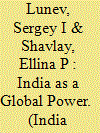

|
|
|
|
|
| Summary/Abstract |
The article reviews India’s contested role of a great power in global politics. Although showing tangible results across all the aspects pertaining to the great power status, in international relations India is still largely underestimated and even overlooked. Politicians and scholars generally mention three main reasons behind that phenomenon: weak social and economic figures, the country’s relatively narrow global impact and the absence of strategic culture. We argue that the latter is key, and that it is in the process of being remedied. In fact, India already has all the prerequisites for being recognised as a ‘great power’, since it has political, military, economic and cultural capabilities corresponding to the status. It is simply a matter of time and coordinated efforts of the government to formulate and implement a consistent foreign policy and economic strategy as well as a change in Indian elite’s strategic thinking which will enable untapping India’s existing potential and successfully meeting the objective of increasing its influence in global politics.
|
|
|
|
|
|
|
|
|
|
|
|
|
|
|
|
| 4 |
ID:
182612
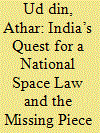

|
|
|
|
|
| Summary/Abstract |
As the commercial use of outer space becomes feasible, the nature of possessory rights will potentially emerge as the central focus of future space-related activities. The existing international law relating to outer space does not address in detail the nature of possessory rights in outer space and is subject to multiple interpretations. Alarmingly, the recently adopted space policies and legislations by some States have taken a definitive position regarding the commercial use of natural resources in outer space.
|
|
|
|
|
|
|
|
|
|
|
|
|
|
|
|
| 5 |
ID:
182613
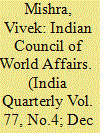

|
|
|
|
|
| Summary/Abstract |
This commentary recounts the important hallmarks of the institutional history of the Indian Council of World Affairs, one of India’s first publicly funded research institutions. It presents a brief account of its long history since 1943, its career in acquiring prominence, its decline and its revival. This commentary takes off from its recently published institutional history (Raghavan, T., & Mishra, V. [2021]. Sapru House: A story of institution building in world affairs).
|
|
|
|
|
|
|
|
|
|
|
|
|
|
|
|
| 6 |
ID:
182610
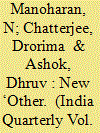

|
|
|
|
|
| Summary/Abstract |
One of the key terms to understand the nature of violence and conflicts world over is ‘radicalisation’. Sri Lanka’s case is instructive in understanding the various dimensions of Islamic radicalisation and de-radicalisation, especially in South Asia. Though a small state, Sri Lanka has witnessed three radical movements, the latest being Islamic that got manifested in deadly Easter attacks of April 2019. Eco-space for Islamic radicalisation existed in the island for decades, but the rise of ultra-Sinhala-Buddhist nationalism post the end of Eelam War IV acted as a breaking point. The underlying context is perceived as the feeling of insecurity projected by hardline Sinhala-Buddhist elements. In due course, the primary ‘other’ shifted from Tamils to Sri Lankan Muslims. Apart from inter-communal dissonance, international jihadist network also fostered radicalisation process in the island’s Muslim community. Political instability due to co-habitation issues between the then president and the prime minister was a perfect distraction from the core security and development issues. In response to the violent manifestation of radicalisation, de-radicalisation measures by the successive Sri Lankan governments were mostly military in nature. Socio-economic and political components of Islamic de-radicalisation are at the incipient stage, if not totally missing. The article suggests wide-ranging measures to address the issue of radicalisation in the island state.
|
|
|
|
|
|
|
|
|
|
|
|
|
|
|
|
| 7 |
ID:
182608
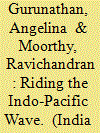

|
|
|
|
|
| Summary/Abstract |
India and the Association of Southeast Asian Nations’ (ASEAN) partnership began in the early 1990s mainly in the economic domain. Reeling from a major internal crisis, India wanted to tap onto the region’s economic vibrancy to strengthen its own waning economy. Since then, amidst India’s domestic constraints, economic ties have largely sustained the India–ASEAN partnership on a steady course. India’s withdrawal from the ASEAN-led Regional Comprehensive Economic Partnership (RCEP) negotiations in 2019, therefore, was an important inflection point in the partnership. This study, hence, discusses the prospects for the India–ASEAN partnership moving forward beyond the RCEP. This is undertaken by first examining the main challenges India faces with the ASEAN Free Trade Arrangement and the RCEP. After which, relevant developments pertaining to India’s multilateral partnership within the Indo-Pacific theatre as well as to India’s economic trajectory are deliberated in relation to ASEAN. Based on this analysis, this study argues that the outlook for India–ASEAN ties remains optimistic since the external and internal pressures needed for important economic reforms has not diminished for India. In addition, there are prospects for wider engagements with ASEAN due to Indo-Pacific-related strategic recalibrations in the region. Therefore, collectively these factors will provide crucial thrusts for the partnership to move forward strongly sans RCEP.
|
|
|
|
|
|
|
|
|
|
|
|
|
|
|
|
| 8 |
ID:
182607


|
|
|
|
|
| Summary/Abstract |
India dropped out of the Regional Comprehensive Economic Partnership (RCEP)—which included the Association of Southeast Asian Nations (ASEAN) countries, China, South Korea, New Zealand, Japan and Australia—after negotiating for almost seven years in November 2018 on the grounds of national interest and also that free trade agreements (FTAs) did not amount to free trade and led to more trade diversion than trade creation. The cost and benefit of a regional agreement depend on the amount of trade creation with respect to trade diversion (Panagriya, 2000). This study tries to examine India’s concerns and, at the same time, highlights the cost of not joining RCEP. India’s trade deficit with 11 out of the 15 RCEP nations has been a major cause of concern. Unfavourable trade balance, concerns about the impact on dairy sector, economic slowdown, past experience with FTA’s, China factor, data localisation, rules of origin and the experience of ASEAN countries with Sino-FTA have been some of the reasons behind India’s decision to opt out of this mega multilateral agreement. Also, bilateral trade agreements with some RCEP countries such as Japan, Malaysia, Singapore, Thailand and South Korea were operational. A multilateral trade agreement with ASEAN countries was very much in place. So, trade between India and 12 of the RCEP member countries would not have changed much after India’s inclusion in the RCEP. The impact of lower tariffs would have been evident for the remaining three countries: China, Australia and New Zealand. Furthermore, there was fear of a massive surge in imports of manufactures from China and dairy imports from Australia and New Zealand. This study also examines the long-term impact of this decision and if India has missed out on becoming a part of the global value chain and gaining greater market access in the Asia-Pacific region. India’s policy of import substitution and protectionism did not capitulate desired results in the past. Hence, a critical evaluation of India’s decision and some validation on her concerns and fears have been done.
|
|
|
|
|
|
|
|
|
|
|
|
|
|
|
|
|
|
|
|
|